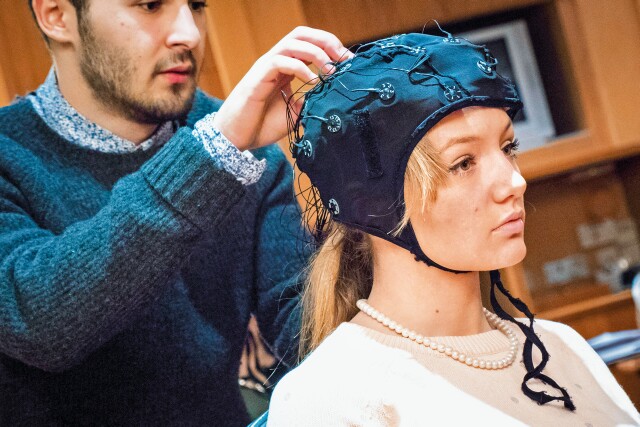MFM -- Understanding How Memory Motivates Consumers and Its Impact on Media and Advertising

Say you're the head of marketing at a major consumer packaged goods company, and you've produced a spot for an up-and-coming tea brand. Warm, romantic storyline about a couple drinking tea, throwing witty dialog back and forth. Sexual frisson. You get the drift. Their mini-story reaches a conclusion 27 seconds in, followed by a bright blue screen -- the brand's defining color -- and then the tea logo. It's a beautiful thing to behold. Except the response from consumers is lukewarm. Not enough people are remembering the brand name. They aren't properly motivated to buy your delicious rose-hip lemonade concoction, or that basil-green tea variety. At what point did the commercial go wrong? And how do you trial alternative messages to make the right impact?
One of the deepest ways of getting at those answers involves studying consumers' subconscious, their memories, and how that motivates them (or not). Pranav Yadav (pictured below) has studied this in minute detail. He's the CEO of the Americas and Europe for the research company Neuro-Insight. "Memory is a guideline for future behavior," he said. "It informs who we want to be in the future."

For example, a certain consumer's memory of a hip mobile commercial might motivate them to trade in their clunky 2015 model because they really want to enhance their cool factor with certain people.
Neuro-Insight has developed a technology that measures memory. It involves placing a head cap with a lot of wiring coming out of it on the heads of various study respondents (see photo at top).
Known as Steady State Topography (SST), the tech was originally developed to track brain abnormalities related to attention-deficit hyperactivity disorder (ADHD). "We were trying to invent a brain-mapping technology that could overcome some of the limitations of traditional EEG methodology," explained Yadav. "We found out that, wow, we are particularly good at measuring memory. And wow, memory correlates to future purchase behavior."
Invite job candidates to apply live during the Media and Advertising Community’s Black Talent Outreach Week at MediaVillage.com and AdvancingDiversity.org October 17-20. Apply for jobs/submit your resume here.
Keri Degroote, Senior Vice President of Sales Research and Analytics at SXM Media, explained the attraction for media companies this way: "When we were first evaluating different neuro-research vendors, Neuro-Insight's Steady State Topography methodology really stood out to us from others, who use more standard methods like EEG and fMRI. Their SST method has many benefits like larger sample sizes and single exposure measurement."
(EEG, or electroencephalogram, is a test that measures electrical activity in the brain using small, metal electrodes attached to the scalp. And fMRI is short for functional magnetic resonance imaging. It measures brain activity by detecting changes associated with blood flow.)
Yadav explained that SST tracks the speed of electrical activity in different parts of the brain, and therefore is a better indicator of memory than, say, eye tracking or facial encoding. As part of that, it can gauge how consumers process content based on the type of media that they're watching.
In other words, it's a sort of a "thermometer," as Yadav puts it. "The tool is sophisticated in its ability to tell you how people are feeling. But it cannot change how people are feeling." SST gives companies a reality check on how well their messages and stories are perceived and remembered. Then companies can adjust the content; use SST again; see if there are improvements.
At the same time, Neuro-Insight has been able to develop certain learnings that help to point marketers and other content providers in better directions. It's able to determine where dips in memorability occur. One phenomenon it's pinpointed is referred to as conceptual closure. That's what was wrong with that romantic tea commercial that no one could remember properly.
After a commercial's storyline reaches a conclusion, a lot of brand messages "are going to take over the screen with the brand color, yellow, orange, red—whatever it may be. The music will come to an end, and then the brand [name] shows up," Yadav said.
Problem is, "when the story is coming to an end, you shut off your memory doors to process what you've just received," he explained. "If your brand comes in right after you've shut off those memory doors, you've basically wasted the 27 preceding seconds."
Some Neuro-Insight research has focused on how consumers respond to different media, and the results might seem counterintuitive. For example, one SST study showed that if research participants freely interacted with social media platforms like Twitter while simultaneously watching a live video broadcast, there was "significantly" enhanced viewer engagement with the TV program. That's what the neural indicators showed.
Multitasking matters!
NPR has used Neuro-Insight to get a deeper understanding about how it stacked up against competitors. Its most recent SST study focused on trust. "We wanted to see it through the lens of corporate responsibility marketing, which is so critically important," related Susan Leland, Associate Director of Audience Insights at NPR.
"We found that NPR is highly trusted and outperformed a competitive news brand," Leland said. When focused on detailed memory encoding prompted by branding messages, "NPR was highly effective in conveying that memorability, and more so than the video asset we were comparing it to."
Another comparison study was done with SXM. "We did a study with Neuro-Insight on beauty advertisements that proved that beauty audio ads on Pandora were more effective than norms for print, TV, and radio ads for branding moments," said Degroote. "When there is strong audio creative it can be the best tool for breaking through as your brain puts together the visual, hence it works harder and goes into your long-term memory."
Yadav sees changes up ahead for the SST technology, and what Neuro-Insight might provide in five or 10 years. "Cloud technology is moving at a pace where I will be able to save all of the data and process that data in real time. The hardware technology is improving quickly as well," he said.
"Our scale will be unprecedented. And then, once you actually get to a critical mass of data with AI and machine learning technologies, you can build predictive models that will blow anything that we know out of the water right now."
Click the social buttons to share this content with your friends and colleagues.
The opinions and points of view expressed in this content are exclusively the views of the author and/or subject(s) and do not necessarily represent the views of MediaVillage.com/MyersBizNet, Inc. management or associated writers.


